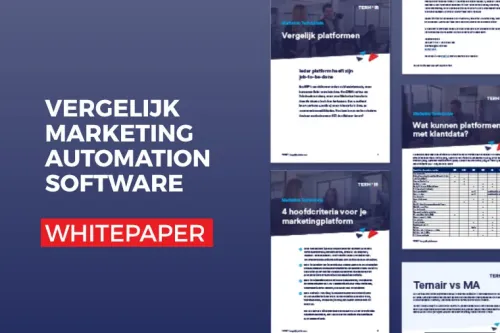3. You can get ahead now
The offer is there, so why isn't every company using marketing automation now? It's mostly because of the way companies are set up. Choosing marketing automation coincides with choosing to put the customer first. After all, that also means putting customer data at the center and using it to improve customer relationships.Data-driven work is something that concerns the entire organization, not just the marketer. Thus, at some point, organizations will have to start moving customer data from an ERP to a CRM package. And establishing and measuring KPIs will then improve processes. For big steps like this, the entire organization will have to make a change. The business side can take the lead in this when it becomes clear that there are currently great opportunities. Do you find yourself in a market where no one is yet using marketing automation to personalize and continuously improve the customer journey? Then you can gain competitive advantage right now.
4. Get a grip on customer interaction
Marketing becomes easier with the right tooling. As a result, a marketer needs less of a technical background and more of a passion to shape the customer relationship. The customer journey becomes more measurable and insightful, allowing you to coordinate omnichannel communications from one place. Behind it, as a marketer you will have to create insights into customer processes and creatively shape the customer relationship. This leads to new questions such as: what does the customer need at this step in the customer journey? What opportunities are there when we connect this system to our marketing tool? What other systems can we connect to? Marketing automation gives you a grip on the entire customer journey, allowing you to truly put the customer first. As a result, the focus shifts to creating customer value.
5.Real-time 360-degree customer view and responding to customer needs
Quant to customer data, the focus has shifted from demographics, backgrounds and interests to actual customer behavior. This is because it is now possible to capture and enrich customer interaction across touchpoints in real time. The big enabler for this are APIs that make real-time data data available, such as click behavior on a newsletter, product pages visited or the contents of an abandoned shopping cart. The more you then act on that behavior again, the more data you can collect again that will give you a better picture. Responding directly to customer needs in this way becomes possible by setting triggers and business rules. For example, when a visitor views three products from a specific category but does not buy, you can use a banner on the site to point out a product comparison in this category. How the visitor responds to that in turn gives you more insight into the phase the visitor is in.
6. Fine-tuning your push strategy
The game between capturing customer behavior and initiating interaction gives you all the ingredients for fine-tuning your push strategy. An example is someone who has just bought a new house and is looking for a new floor. Laminate, tile or residential concrete? What are the pros and cons of each option? If this person thinks about residential concrete, then new questions arise: what are the differences from a cast floor or a microcement floor? The flooring brand that has insight into this customer journey can provide content from orientation to purchase in the form of explanations, comparisons, buying guides and maintenance tips. This way, as a brand, you build your brand awareness and brand preference, so the choice at the final purchase is driven from the outset.
The business case for marketing automation
These six reasons will particularly appeal to marketers, but you will also need to substantiate the choice of marketing automation internally. To convince the internal organization, especially the board, you will need to build the business case for marketing automation. To do this, look from your current insights into the effect of your marketing to what improvements in lead generation, revenue and customer satisfaction you can expect by using marketing automation. Are you not yet clear on what marketing automation can do for your company? Orient yourself first and get in touch with parties that are successfully putting marketing automation into practice. They can help you build that business case and translate it to your market. That is exactly what Ternair does for brands like Bouwmaat, Vesting Finance, BNNVARA and VluchtelingenWerk.





